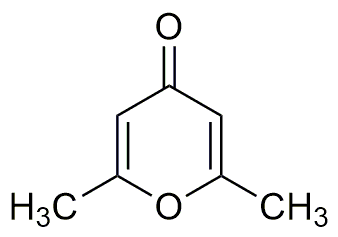2,6-Dimethyl-?-pyrone is widely utilized in research focused on:
- Flavor and Fragrance Industry: This compound is used as a flavoring agent in food products and beverages, providing a sweet, caramel-like aroma that enhances consumer appeal.
- Pharmaceuticals: It serves as an intermediate in the synthesis of various pharmaceutical compounds, contributing to the development of new medications with improved efficacy.
- Natural Product Synthesis: Researchers employ this compound in the synthesis of natural products, which can lead to the discovery of new bioactive compounds with potential therapeutic benefits.
- Polymer Chemistry: It is utilized in the formulation of polymers, where it can improve the properties of materials, such as flexibility and thermal stability, making them suitable for various applications.
- Analytical Chemistry: The compound is used as a standard in analytical methods, aiding in the identification and quantification of similar compounds in complex mixtures.
General Information
Properties
Safety and Regulations
Applications
2,6-Dimethyl-?-pyrone is widely utilized in research focused on:
- Flavor and Fragrance Industry: This compound is used as a flavoring agent in food products and beverages, providing a sweet, caramel-like aroma that enhances consumer appeal.
- Pharmaceuticals: It serves as an intermediate in the synthesis of various pharmaceutical compounds, contributing to the development of new medications with improved efficacy.
- Natural Product Synthesis: Researchers employ this compound in the synthesis of natural products, which can lead to the discovery of new bioactive compounds with potential therapeutic benefits.
- Polymer Chemistry: It is utilized in the formulation of polymers, where it can improve the properties of materials, such as flexibility and thermal stability, making them suitable for various applications.
- Analytical Chemistry: The compound is used as a standard in analytical methods, aiding in the identification and quantification of similar compounds in complex mixtures.
Documents
Safety Data Sheets (SDS)
The SDS provides comprehensive safety information on handling, storage, and disposal of the product.
Product Specification (PS)
The PS provides a comprehensive breakdown of the product’s properties, including chemical composition, physical state, purity, and storage requirements. It also details acceptable quality ranges and the product's intended applications.
Certificates of Analysis (COA)
Search for Certificates of Analysis (COA) by entering the products Lot Number. Lot and Batch Numbers can be found on a product’s label following the words ‘Lot’ or ‘Batch’.
Numéro de catalogue
Numéro de lot/série
Certificates Of Origin (COO)
This COO confirms the country where the product was manufactured, and also details the materials and components used in it and whether it is derived from natural, synthetic, or other specific sources. This certificate may be required for customs, trade, and regulatory compliance.
Numéro de catalogue
Numéro de lot/série
Safety Data Sheets (SDS)
The SDS provides comprehensive safety information on handling, storage, and disposal of the product.
DownloadProduct Specification (PS)
The PS provides a comprehensive breakdown of the product’s properties, including chemical composition, physical state, purity, and storage requirements. It also details acceptable quality ranges and the product's intended applications.
DownloadCertificates of Analysis (COA)
Search for Certificates of Analysis (COA) by entering the products Lot Number. Lot and Batch Numbers can be found on a product’s label following the words ‘Lot’ or ‘Batch’.
Numéro de catalogue
Numéro de lot/série
Certificates Of Origin (COO)
This COO confirms the country where the product was manufactured, and also details the materials and components used in it and whether it is derived from natural, synthetic, or other specific sources. This certificate may be required for customs, trade, and regulatory compliance.


